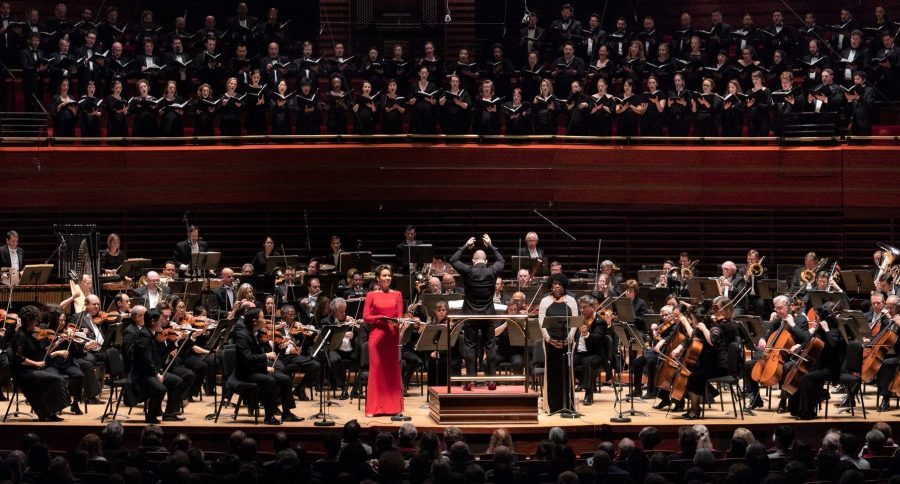
Two pieces of music with similarities — but so different! Gioachino Rossini’s Stabat Mater and Leonard Bernstein’s Kaddish both are choral works with religious texts, yet are radically diverse.
Yannick Nézet-Séguin led massive forces in a Philadelphia Orchestra program that juxtaposed these two approaches to faith.
Bernstein’s 1963 composition is actually his Symphony No. 3, subtitled Kaddish. That is a misunderstood Jewish prayer. While it’s recited at funerals and on the anniversary of deaths, the word “death” doesn’t appear. Rather, the text praises God and proclaims everlasting faith.
But Bernstein’s version is far from comforting. He added a female narrator who angrily confronts God. She is upset that the world contains evil and strife. The composer said the narrator was, in one sense, himself. Yet he also said it was “Das ewig Weibliche (the eternal feminine.) It was that part of man that emotionally intuits God.” Bernstein wrote new words to start it:
“O, my Father: ancient, hallowed, lonely, disappointed Father:
Betrayed and rejected Ruler of the Universe; angry, wrinkled Old Majesty.
Are You listening, Father?”
As the piece progresses, the original prayer in a combination of Hebrew and Aramaic is sung by soprano Nadine Sierra, the 80-voice Philadelphia Symphonic Choir, and the 55-voice Philadelphia Boys Choir.
In a conversation, Bernstein said he wrote the Speaker for a female because it turned upside-down the religious tradition where only males are allowed to lead prayers. At these concerts, the role is taken by Charlotte Blake Alston who is black and thus adds an element of universality. Unfortunately, her enunciation was indistinct and its amplification produced some echo.
Bernstein’s partial use of the “twelve-tone system” in this piece is an interesting feature. In the post-World War II era, many academicians said that the system proclaimed by Arnold Schoenberg was the correct way to write, and Bernstein’s romantic melodies should not be taken seriously. Bernstein frequently talked about how offended he was by this orthodoxy.
(In the system, a composer must create a series of twelve notes which have to be repeated in various guises before any other notes can enter. Opponents call it dissonant, but that’s an oversimplification. Let’s just say it produces an unsettling sound.)
Bernstein rejected the rigidity of the technique. In this symphony he took on the challenge of proving he could utilize it if he chose to, and said, “One of the main points of the piece is that the agony expressed with the twelve-tone music has to give way — this is part of the form of the piece — to tonality and diatonicism [using only the tones of a standard scale] so that what triumphs in the end, the affirmation of faith is tonal.”
The twelve-tone sections come in the middle, when Bernstein’s text complains about God’s failure to make the world a better place. The subtle entrance of the boys choir was breathtaking, as Bernstein’s music transitioned to a comforting lullaby. The symphony’s final chord is dissonant, suggesting that all is still not right in the world and more work must be done.
After intermission came the piece that Rossini wrote after he retired from the composing of operas. It is melodiously catchy, in the style of his mid-career; not with the grandiose scale of his last opera, William Tell. Other critics have chastised Rossini for composing prayers that sound lightweight. I, however, love the way he brings accessibility to this portrayal of Mary attending the crucifixion of her son.
Nézet-Séguin brought out the ethereal sacred context, sublimating the bombastic elements. For instance, John Osborn sang the march-tempo Cujus animam (“Her spirit”) which has often been belted by tenors as if it’s an aria. He sang with restraint and subtlety. Krzysztof Baczyk, a cantabile bass, sang with convincing tenderness. Nadine Sierra brought grand style to her dramatic Inflammatus (just as she did in her part in the Kaddish.) She is an emerging talent; currently starring as Gilda in Rigoletto, her large voice is capable of more substantial roles. Sierra was statuesque in a form-fitting red gown.
Elizabeth DeShong was outstanding as the mezzo soloist. Her voice has projection and color, and is evenly produced from top to bottom. She was a perfect foil for Angela Meade in last year’s Semiramide at the Met and I’d love to see her someday as Adalgisa in Bellini’s Norma. The chorale sang with delicacy and swelled impressively to fortissimo climaxes.
Yannick, by the way, is conducting these days without a baton, at Philadelphia Orchestra concerts and even in the Met’s huge pit. He says it gives him more ability to express emotions.